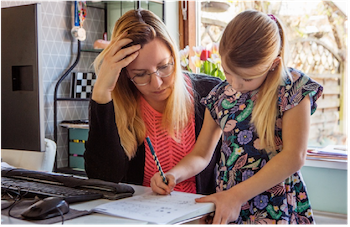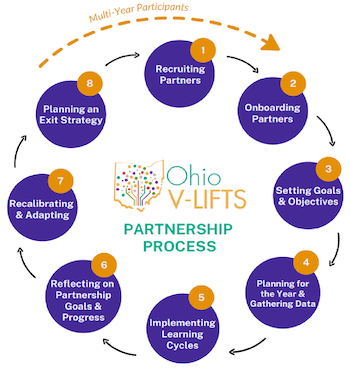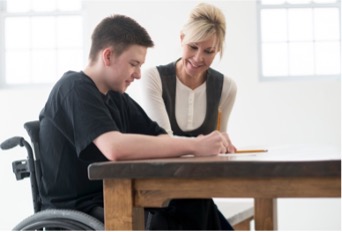Dalton Local Schools’ Focus on Reading Science: “We’re All Reading Teachers!”
May 2025
In rural Dalton Local Schools – a small district in Wayne County serving about 900 students in three schools (one elementary, one middle, and one high school) – educators are unified in their focus on improving the literacy achievement of all learners across the district.

“With literacy being a huge focus in the district, we really are supporting the fact that all teachers are reading teachers. This represents a huge overall collaboration in this district; from K to 12, we're all reading teachers. It doesn't matter what subject you're teaching; you are a reading teacher in some form,” said Lisa Zona, Dalton’s Director of Student Services, Curriculum and Instruction.
District One Plan Supports Unified Focus, Consistent Implementation
Literacy is Goal #1 in Dalton Local’s 2024-2027 One Plan. Specifically, Dalton’s goal reads: By June 2027, 100% of Dalton Local School District students will meet or exceed expected Literacy/English Language Arts growth as measured by State Report Card data and/or other district-approved measures. The One Plan is a systemic consolidated planning tool strategically aligned to funding, resources, and focused on improving outcomes for all students (Ohio Department of Education and Workforce, 2024).

“The One Plan is our strategic plan, slash district plan. We’ve started bringing in professional development and that’s basically what our plan is centered on, and driving all of the work through data,” explained Mrs. Zona.
Consistent implementation across the district is facilitated through clear communication and the use of the Ohio Improvement Process (OIP) and an interconnected set of teams at the district (District Leadership Team or DLT), school (Building Leadership Teams or BLTs), and classroom (Teacher-based Teams or TBTs) levels. Mrs. Zona credits use of the OIP and One Plan with helping the district to focus on what’s important for all children. “That's due to the One Plan and the OIP process; it has really focused us in on what we need to do,” she said.
Effective use of OIP team structures; however, wasn’t always the case. In fact, as Mrs. Zona describes, staff heard the terms DLT, BLT, TBT, but “other than TBT, which the staff was actively involved in every week, the other ones were just names. The staff didn’t know their purpose or who was even on the teams. So, even though the structure has been there, we now have more focus on how the teams are used; we’re very intentional now.”
Now, Dalton’s DLT meets every other month. BLTs meet during the same months to discuss and address DLT priorities with additional BLTs meetings held on an as-needed basis. TBTs meet weekly with time built into the school day to accommodate meetings. “For every DLT meeting, our principals have to get coverage for the teachers that need to come in. We do it and we move forward because we know it's important. In the past, we kind of ignored it and you could see we were not moving as quickly as we are now. So it's a nonnegotiable now. We have to do this even though it's hard; it is hard and painful because of time and subs,” said Mrs. Zona.
Clear communication and prioritizing teaching and learning by focusing the work of teams on instructional improvement is making a difference in Dalton’s capacity to improve literacy achievement.
The Ohio Improvement Process (OIP)
The OIP uses a five-step “plan-do-study-act” process in concert with aligned leadership team structures [i.e., district leadership team (DLT), building leadership team (BLT), teacher-based team (TBT)] to support improvement of teaching and learning across the system. Resources available from the Ohio Leadership Advisory Council (OLAC), including the 3rd edition of Ohio’s Leadership Development Framework (BASA, 2022) support Ohio local education agencies in using the OIP to implement effective practices on a districtwide basis.
More information about the OIP is available in OLAC online learning modules and videos:
OLAC Online Learning Modules
Communication is key. Two-way communication – from TBTs to the DLT, and from the DLT to TBTs – is critical to establishing and maintaining focus on the most essential priorities. Mrs. Zona explains:
“One of the big things that came out of the root cause analysis, and I really take ownership for it because it was new to me as well, was that there was not a lot of communication. People did not understand why we were doing what we were doing. We were making these changes and initiatives. And in my brain, it made total sense, but not everybody else understood it if they weren't working closely with me. So we really had to beef up that communication and the “why” behind what we were doing. It's made a huge difference.”

Samantha (“Sam”) Giammarco, a Research Associate with the Dublin-based University of Cincinnati Systems Development & Improvement Center (UC SDI), works with Mrs. Zona and other staff at Dalton Local to use evidence-based literacy practices commonly known as the science of reading (SoR). “The one thing that I've seen consistently since a year ago is that the messaging is very clear from the superintendent to Lisa (Zona), to all three school principals, and to Kara as the literacy coach. You're all saying the same thing. You're all saying every student will learn to read and write, every student is capable of learning to read and write, and every teacher will teach students how to read and write. It's very clear; I see it at all levels and that's very rare,” she observed.
Kara Good, Dalton’s Literacy Coach, agrees: “communication is where I’ve really noticed the difference in the last couple of years; we now know what's going on, where it's coming from, why we're doing it, and what we need to do next.”
Intentional focus on instructional improvement. Not only has clear communication about the purpose and function of Dalton’s DLT, BLTs, and TBTs made a positive difference, but so has ensuring that instructional improvement is the sole focus of team meetings. Giammarco observed that “the TBT structure was changed a little bit this year to allow for more of an instructional focus across grade levels and content areas.” This increase in effective team functioning was evident at all schools, including the high school, where establising TBTs was described by Mrs. Zona as “tricky.”

Giammarco recalls a conversation with the high school principal who relayed that TBTs didn’t seem to be as productive at the beginning of the school year as they are now, particularly after teachers participated in professional learning on reading science. “He said, ‘I walked in and saw a group of teachers talking for 40 minutes all about vocabulary.’”
Leadership to build the instructional capacity of teachers in all schools has also led to a shift in focus – away from a focus on compliance (i.e., going through the steps in the process and checking them off) to a focus on improvement for each child, including those receiving special education services. “We were so focused on compliance and IEPs and minutes and everything else, which we have to be, but oh my goodness, taking time and being involved in this process is essential to making sure all students learn and are successful,” said Mrs. Zona.

Dalton Local’s rate of identification of students with disabilities in need of special education support is lower than the state average (i.e., about 10% as compared to the state average of about 16%), suggesting that special education is not viewed as the only recourse for addressing student instructional needs. As Mrs. Zona explains, “that has been a mind shift in this district. I can't really say if we've had higher numbers or not in the past, but I can say we are being more resourceful and intentional in providing strong core instruction and Tier 2 and 3 interventions before we just jump to special education. All kids can learn; they just might learn a little differently. The expectation in this district is that all students will read.”
All Ohio Literacy & Learning Science
In Fall 2024, Dalton Local signed on as a partner district in the Ohio Virtual Literacy Improvement for Teachers and Students (OH V-LIFTS) project, a project developed and implemented by the UC SDI Center with support from the Ohio Department of Education and Workforce (DEW), Office for Exceptional Children. The intent of the project is to build the capacity of teachers serving as district-school literacy coaches and districtschool teams to improve the literacy achievement of all children, particularly students with disabilities and learning challenges.

Dalton’s involvement in the partnership has included a K-4 Core Team and a 5-12 Core Team focused on many of the same evidence-based literacy practices (e.g., explicit vocabulary instructional routine) across the entire district.
OH V-LIFTS provides high-quality literacy professional learning grounded in the science of reading and aligned with Ohio’s Plan to Raise Literacy Achievement (2025). It supports the state’s strategic priority in literacy (i.e., that EVERY student reads at/above grade level). Districts commit to a three-year partnership that uses a train-the-trainer model in order to build the foundation for sustainable and scalable literacy improvement.
Beginning in Fall 2025, the first year of the partnership will be focused on supporting the school literacy coach. The coach will receive training in evidence-based language and literacy practices using the ALL Ohio Literacy resources, the V-LIFTS partnership process (see the 8-step process illustrated here), and literacy leadership. In the second year, the literacy coach will lead the development of the V-LIFTS Core Team in evidence-based language and literacy practices. In the partnership’s third year, the coach and Core Team train and provide implementation support for teachers on literacy topics that align with district and school literacy priorities.

Dalton’s shift to the science of reading and the support provided through All Ohio-V-LIFTS has led to improvements, not only at the elementary level, but across the board. “I'm embarrassed to admit it, but we had stopped phonics in second grade. When we started digging into the data and curriculum and realized we just did not have instruction being delivered in phonics anywhere after second grade, we made a change. We all need to be implementing the same phonics curriculum across the district, and especially at K-5,” said Mrs. Zona.
“Our K-4 building knows what they need to do. Now, we need to give them time to get their academic vocabulary in place, decide who's going to do what, and how we're going to support it. So our goal next year is to give them time to implement because they teach all content areas and then continue with V-LIFTS in grades 5 through 12 because we’re still in the learning phase and just need more coaching. I think next year is going to have a large focus on coaching and implementation,” she explained.
Coaching as an essential part of PD. Coaching to support the application of instructional practices learned through any training or professional development program is essential in improving adult and student outcomes. Research on coaching supports its use to improve educator practice and student outcomes and as an essential component of effective implementation (WestEd, NCSI, 2014). Influential work by Joyce & Showers’ (1982) suggested that implementation of new practices learned through PD was as high as 80 to 90 percent when ongoing coaching was provided, as compared to 10 to 20 percent without coaching.
District leadership personnel recognized the importance of coaching in participating as a V-LIFTS partner. According to Mrs. Zona, “Every district needs to bite the bullet and get a literacy coach if they want to see growth in their literacy program; it's key!” Transitioning Kara Good, who served for about 15 years as a Title I intervention teacher, to the role of Literacy Coach was essential to supporting teachers in the use of evidence-based literacy practices. “Teachers respect Kara’s opinion because they know she knows what works. She has been a key piece in improving instructional practice and encouraging teacher buy-in,” she said.
MTSS. In addition to identifying the type of professional development and coaching teachers would need, Dalton Local also worked on using new curricula consistently and with fidelity, and on using a multi-tiered system of supports (MTSS) approach to effectively address students’ varied learning needs. “We wanted to get the right supports in place and make sure we used targeted interventions to improve literacy. V-LIFTS just came in and was able to help us with all of these different areas with the modules we chose and the really consistent support we got from Sam,” explained Good.

“We knew we had to focus on the core issues in our literacy program across the district because if your core instruction isn’t strong, your tier 2 and 3 won’t be effective because all students will need intervention. So our V-LIFTS partnership had a huge Tier 1 core focus,” said Mrs. Zona. “You can't do anything without a strong MTSS structure. Your students aren't going to grow; your interventions aren't going to be the right targeted interventions. And we rely on that. We have a great team of Title teachers that 100% live our MTSS structure,” she added.
All Ohio Literacy & Learning Science. V-LIFTS professional learning draws on resources developed by the UC SDI Center, collectively housed on the All Ohio Literacy website. All resources are aligned with Ohio’s Plan to Raise Literacy Achievement and the Ohio Department of Higher Education’s 12-Hour Reading and Literacy Core Standards and include more than 36 comprehensive, asynchronous literacy learning modules, including 10 OCCRRA-approved modules, organized into the following five series:
- Foundational Literacy Topics Series
- Early Childhood (Birth to Age 5) Series
- Primary Literacy Series
- Adolescent Literacy Series
- Multilingual Learner Series
Giammarco serves as the All Ohio/V-LIFTS project director, providing professional learning to Dalton faculty and staff. “We had everyone in the room. We had specials teachers, we had band, we had everyone in the room and we did the MAZE assessment, which is a part of the DIBELS 8 screener. Everyone administered it to a friend and then graded their colleague’s test. I asked them if they could help with this process and the band teacher said ‘yeah, I could do this with my whole band.’ And so we were able to get that buy-in from everyone in the building,” recalled Giammarco.
“Sam used our actual data during the PD and that made it relevant for teachers and, I think, helped 100% with buy-in because they were seeing their students up there on the screen. We then moved to vocabulary, instructional routines and checklists for both of our core teams – elementary and grades 5-12. Developing common terms and commonality in language across the district was key,” said Mrs. Zona.
A veteran educator having served in many roles (teacher, intervention specialist, director of special education, director of federal programs, director of curriculum and instruction), Mrs. Zona is looking forward to continuing to make improvements in teaching and learning on behalf of each child in the district. “I’m excited about our plans for next year,” she said. “We’ll continue to build that background knowledge, to build that ‘why,’ to ramp up coaching, and putting it all together!”
References
Joyce, B., & Showers, B. (1982). The coaching of teaching. Educational Leadership, 40(1), 4–10.
Ohio’s Plan to Raise Literacy Achievement. (2025). Ohio Department of Education and Workforce.
Pierce, J.D., & Buysee, V. (2014). Effective coaching: Improving teacher practice & outcomes for all learners. WestEd, National Center for Systemic Improvement.
For More Information
For more information about Dalton Local Schools’ work to improve literacy outcomes, contact:
- Lisa Zona, Director of Student Services, Curriculum and Instruction, Dalton Local Schools, at 330-828-2405, or via email at lzona@daltonlocal.org.
For more information about All Ohio Literacy & Learning resources and supports for districts and schools, contact:
- Samantha Giammarco, MEd, C-SLDI, Research Associate, Systems Development & Improvement Center, University of Cincinnati, at 614-897-0020 (ext. 106), or via email at giammasa@ucmail.uc.edu.
For more information about resources to support districts, contact:
- OLAC Director Mike Trego at trego@basa-ohio.org, or
- OLAC Consultants Jim Gay, PhD at jimgay@basa-ohio.org, Elizabeth Lolli, PhD at lolli@basa-ohio.org, or Karel Oxley at Oxley@basa-ohio.org.